KEY CONCEPTS
•
The microstructure of MoS
2 is key to preventing performance degradation due to oxidation.
•
Nanostructure studies are key to understanding which friction and wear mechanisms are specific to certain length scales and which transcend length scales.
•
Collaboration among academics, vendors and customers is key to extending the benefits of ultra-low friction MoS
2 lubricants to a broader range of applications.
Molybdenum disulfide, or MoS
2, is a diva among solid lubricants. It delivers extraordinary performances—but only if conditions are met to the letter. When special attention is given to the synthesis and testing environment, the coefficient of friction (μ) for MoS
2 can be as low as 0.005. This value approaches the range reported for “near-frictionless carbon” (highly hydrogenated diamond-like carbon).1 More typically, μ for MoS
2 is around 0.05 in vacuum or inert atmospheres. (
see Introducing Molybdenum Disulfide). However, in the sticky reality of ambient conditions, MoS
2 falls short of its potential: When water is present, μ is typically about 0.1 to 0.15 and coatings wear faster. (For perspective, μ ~ 0.15 for Teflon™ [polytetrafluoroethylene, or PTFE] under ambient, atmospheric conditions.)
Introducing molybdenum disulfide
The solid lubricant molybdenum disulfide (MoS
2) is a mined material that is refined to high purity from molybdenite (
see Figure 1). It is a member of the family of transition metal dichalcogenides, which includes such other solid lubricants as molybdenum diselenide, tungsten disulfide and tungsten diselenide. A solid lubricant is a solid material applied to a surface as a powder or thin film (or as part of a composite lubricating coating) to protect the surface and reduce friction and wear.
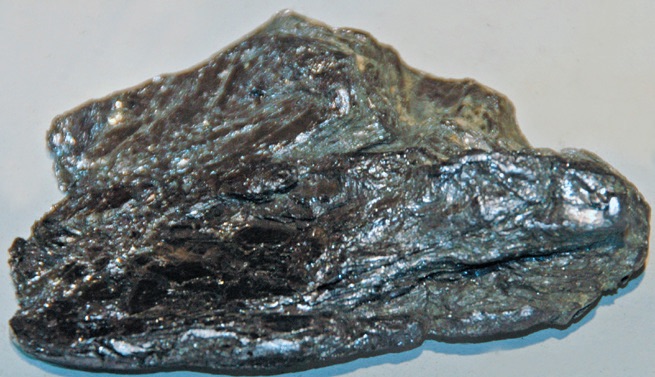 Figure 1. Molybdenite, the ore from which molybdenum disulfide is refined.
Figure 1. Molybdenite, the ore from which molybdenum disulfide is refined.
Like many solid lubricants, MoS
2 has a sheet or platelet structure (
see Figure 2). The platelets, called lamellae, slide freely across each other because bonding between the layers is weak (van der Waals interactions). In air, the friction coefficient is respectable (μ ~ 0.10–0.25). In vacuum, however, MoS
2 truly shines, becoming superlubricious. Friction coefficients in vacuum are typically around 0.05—and as much as an order of magnitude lower under highly controlled conditions.
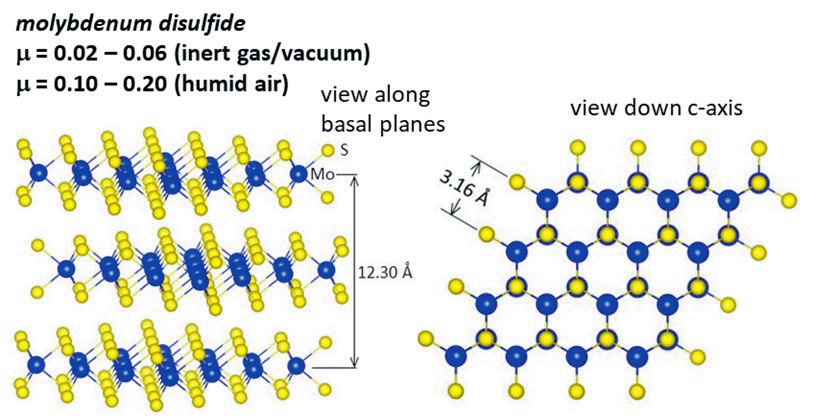 Figure 2. Structure of molybdenum disulfide. Figure courtesy of Michael Dugger.
Figure 2. Structure of molybdenum disulfide. Figure courtesy of Michael Dugger.
MoS
2 has been used as solid lubricant for many decades. In the mid-20th Century, it became of intense interest for aerospace applications, such as satellite components and aircraft engines, because of its unique ability to provide ultra-low friction in vacuum and dry conditions. It also is a constituent of self-lubricating composites with polymers.
Managing this diva’s needs can be challenging. It’s hard to test aerospace components in vacuum and even harder to store them for long periods in ultra-dry conditions. And MoS
2’s diva-ness also means that its super-low-friction performance is out of reach for many Earth-bound applications, where it would help reduce energy needs. Thus, recent research has turned to ways to systematically design coatings that deliver MoS
2’s signature bravura performance under less-than-perfect conditions.
Challenges to high performance
“One of the biggest limitations of MoS
2-based solid lubricants is their susceptibility to environmental contaminants such as water and oxygen,” says STLE member Dr. John F. Curry, senior member of the technical staff in the Material, Physical and Chemical Sciences Center at Sandia National Laboratories in Albuquerque, N.M.
2 High temperatures also are an issue, to a lesser extent, because performance drops off for temperatures above 500 C in vacuum. The reasons for these limitations are not fully clear, but some explanations are emerging.
The effect of moisture on the tribology of MoS
2-based coatings is a perennial problem that has been studied for decades.
3 Humidity has two effects that may have different mechanisms, according to STLE member Dr. Jeff Lince, principal, Space Tribology Consulting, Inc., in Culver City, Calif. First is that the endurance of these coatings degrades when they are stored in humid air environments, for example, in a spacecraft prior to launch. This degradation is a significant problem because space vehicles may be stored for extended periods. In longer exposure to humidity (days to months), the coating may gradually oxidize, with lubricating MoS
2 converting to poorly lubricating molybdenum oxide (MoO
3). In addition to increased wear, oxidation typically leads to higher friction during initial sliding. However, many components in aerospace and defense applications operate just once or for only a few cycles, and these first few cycles can be critical to device performance and success.
The second effect of humidity is the increase in friction and wear observed when MoS
2-based coatings are tested in humid air atmospheres. Even though a component is bound for space, testing has to happen on Earth, and it can be expensive or outright impossible to test coatings under space-like vacuum. Even low-humidity test atmospheres are thought to produce tribological behavior that differs from vacuum. Thus, test results have a degree of uncertainty that might be unacceptable in a risk-averse application such as space flight. For this reason, the industry tends to stick with familiar, “heritage” coatings, although higher performance materials are available.
The challenges are not solely tribological, as Curry notes: “Another issue with MoS
2 materials is that they are usually applied using physical vapor deposition (PVD) techniques, which can only deposit films in line of sight of the target. As a result, applying MoS
2 to complex geometries can be difficult or prohibitively expensive.” A related challenge is the variation of coating properties from vendor to vendor, according to Lince, especially for composite PVD coatings. “For example, several U.S. vendors make Ni/MoS
2 and Au/Sb
2O
3/MoS
2 coatings that are used by U.S. space contractors. However, the friction, and especially the endurance, varies among vendors, even though the coatings are nominally the same,” Lince says. He attributes this variation to differences in process control during deposition.
Understanding the molecular “whys” of performance degradation
Many opportunities would open up if the stellar properties of MoS
2-based solid lubricants were available for a wider range of conditions and environments. Getting to that goal will require a better understanding of the molecular mechanisms that dictate the friction and wear response of this material. A key step is identifying the chemical and structural changes that occur at sliding interfaces under different tribological and environmental conditions. Once the relationships among composition, structure, operating conditions and tribological response are more clearly understood, new and better lubricants can be built through rational design.
Until recently, the chemical and physical complexity of sliding interfaces has stymied progress in enhancing MoS
2 materials. Macroscale empirical testing yielded some insights but was not detailed enough to guide a systematic “materials by design” approach. That’s changing, though, says STLE member Dr. Harman Khare, assistant professor of mechanical engineering at Gonzaga University in Spokane, Wash., where he leads the Tribology Research Laboratory. “Over the last 10-20 years, we have made tremendous progress in our collective understanding of the mechanisms of MoS
2 lubrication, especially compared to what was known in the mid-20th Century.” Advances have come in several areas:
• The mechanisms of lubricity, studied through direct observation of basal slip, including how lamellae reorient or coatings crystallize
in situ;
• The role of oxygen, moisture and temperature;
• The role of dopants;
• The role of coating microstructure and tribochemistry; and
• The creation of “adaptive” coatings whose behavior can shift depending on conditions.
Khare adds, “Significant progress also has been made in understanding MoS
2 tribology at the length scale of one to few layers, which has provided fundamental insights into how effects at crystal edges influence lubricity.” Much of this work has been enabled by new experimental and computational techniques that allow researchers to focus on microstructural aspects of this material. For example, studies can now show interactions between lamellae at the level of a single grain or simulate how MoS
2 interacts with environmental species within the contact region (
see Figure 3).
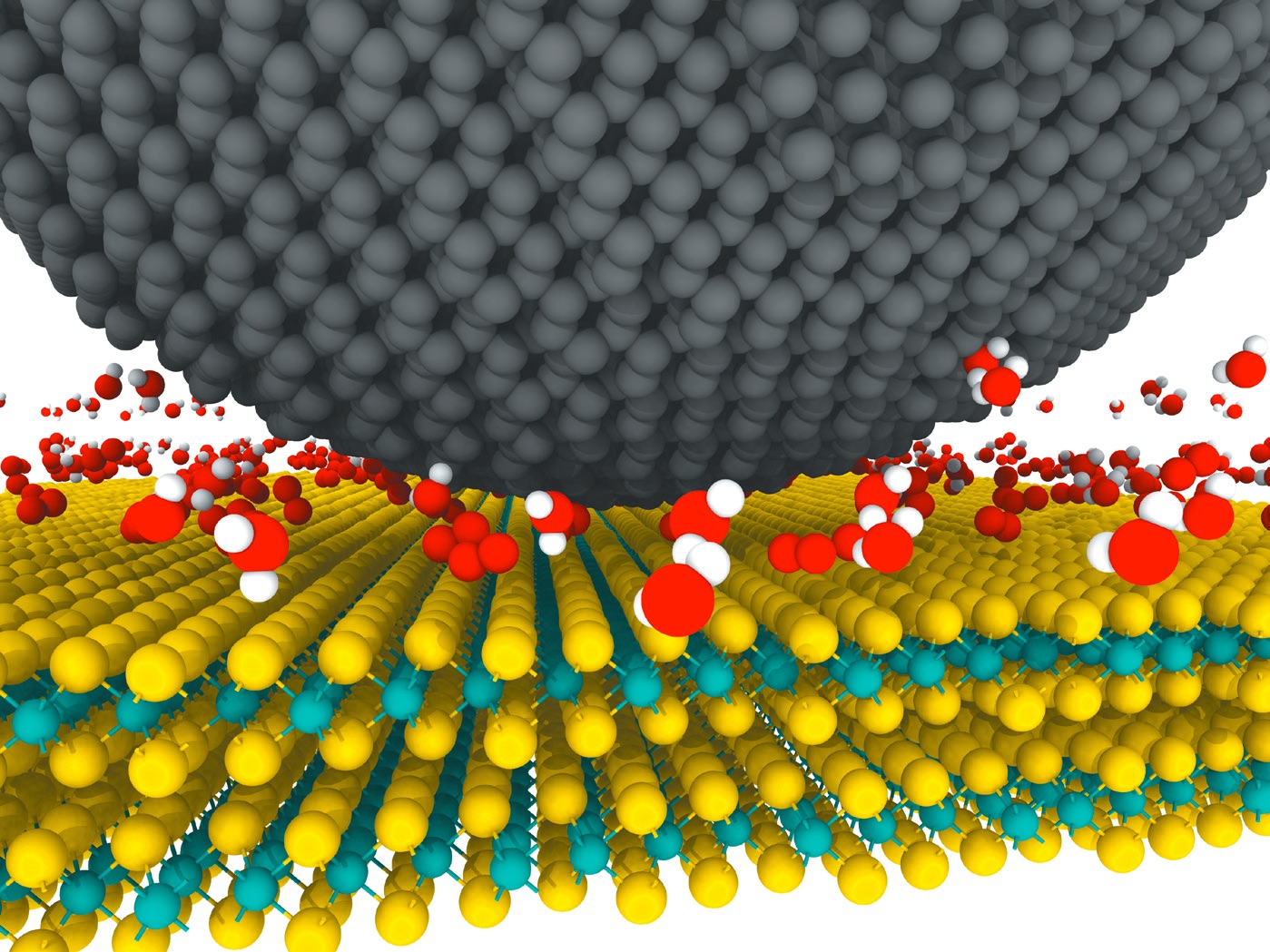 Figure 3. Computational modeling now provides detailed insight into how MoS2 films interact with environmental species, such as water and oxygen, within a contact region. Figure courtesy of Ashlie Martini and Mohammad R. Vazirisereshk. Source: Vazirisereshk, M., Martini, A., Strubbe, D.A. and Baykara, M.Z. (2019), “Solid lubrication with MoS2: A review,” Lubricants, 7 (7). Available at https://doi.org/10.3390/lubricants7070057.
Figure 3. Computational modeling now provides detailed insight into how MoS2 films interact with environmental species, such as water and oxygen, within a contact region. Figure courtesy of Ashlie Martini and Mohammad R. Vazirisereshk. Source: Vazirisereshk, M., Martini, A., Strubbe, D.A. and Baykara, M.Z. (2019), “Solid lubrication with MoS2: A review,” Lubricants, 7 (7). Available at https://doi.org/10.3390/lubricants7070057.
Many of these new analyses have targeted the mechanisms responsible for increased friction and wear in the presence of environmental contaminants (i.e., water and oxygen). According to Curry, “No consensus has yet been reached, but over time two proposed mechanisms have emerged to explain the poor tribological performance of MoS
2 films in ambient conditions (i.e., sliding in air).” The earliest hypothesis suggested that MoS
2 would degrade in the presence of air because oxides (MoO
3) would form during sliding and interfere with low friction. However, as time went on, Curry says, “It became evident that the individual effects of water and oxygen on tribological behavior were distinct, and that adsorption of water alone could lead to high friction without any observable oxidation in track.” Work by Khare and STLE member David Burris of the University of Delaware
4,5 was instrumental in this shift of understanding. “They showed that at higher temperatures (i.e., above 100 C), the presence of oxygen contributed to formation of oxides in the wear scar and subsequently higher friction. However, at room temperature, water was the driving force for increased friction, without any observable oxidation.”
As a result of that work, significant research is now focused on understanding how adsorbed water interrupts shear in MoS
2 contacts. According to Curry, “Over the years, people have suggested polar bonding between lamellae or capillary forces, but without much direct evidence in support of these theories. Our group has done a great deal of research in this area, and our theory is that water can agglomerate at the edges of the sheets of MoS
2 and prevent the formation of larger sheets. This inability to form larger sheets or greater long-range order effectively prevents a low-friction state from being reached.” In this case, it’s not really a question of oxidation. The water is not chemically reacting to form an oxide; rather, it’s physically coating the surface of the lubricant and causing the platelets to interact more strongly.
A related problem is understanding the increased wear observed during in-air testing. As Lince explains, “Increased wear may be related to the poor shear [resulting from physical bonding of water], but it also may be related to changes in the formation and transport of MoS
2 wear debris. Long wear life is usually related to effective cycling of lubricating debris into and out of the contact region. The presence of water may cause these debris particles to agglomerate into larger particles that do not cycle into the contact region, which could increase wear.” If this is true, the entire dynamics of the contact may change. “There’s some question about what actually happens, because it’s physically very difficult to study this process,” Lince says.
In addition to water adsorption, Khare points out that other processes may change the characteristics of the contact region, namely, how the coatings are deposited and how the microstructure develops as result of sliding. “It has been shown that amorphous coatings can recrystallize during sliding. So, if you are depositing coatings with one microstructure, you need to ask whether and how that microstructure evolves when sliding occurs,” Khare says. Further, he cautions, “You have to ask not only about coarse versus fine grains but also about the stoichiometry of the coatings and how many impurities they have, and how that might play a role in the tribology.”
In summary, sliding in a humid environment can be detrimental to dynamic friction behavior, but aging in that same environment (e.g., during storage) can produce detrimental effects on performance down the line, even when operating later in a nominally dry environment. Curry says, “I think the community is close to reaching a better understanding of how water can interrupt shear in dynamic sliding, but we are still far from understanding how these environments can age and degrade MoS
2 films over time and what that means for the resulting changes in microstructure and performance.”
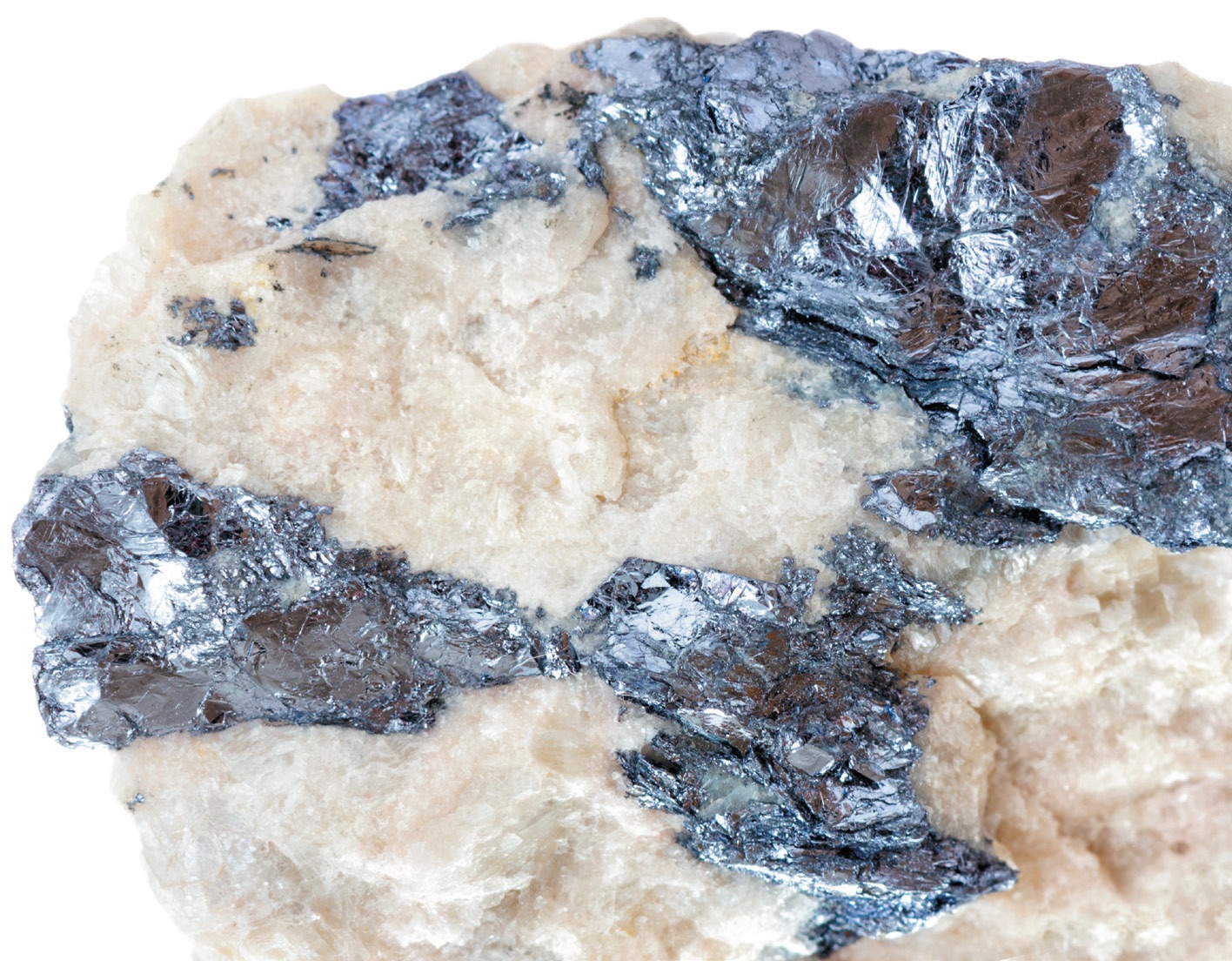 New experimental approaches
New experimental approaches
According to Khare, there are many ways in which advanced nanotribology experiments can help address some of the open questions about MoS
2 lubricants.
•
In situ measurements at the nanoscale and below might offer improved insights into wear mechanisms. These measurements would be crucial in supporting (or refuting) some of the newer hypotheses that have emerged from microscale tribology of MoS
2 in recent years. Methods include atomic force microscopy (AFM) or transmission electron microscopy (TEM), especially ambient TEM.
• AFM measurements also can help elucidate the role of moisture, oxygen and temperature. Recent experimental and computational work have revealed a lot about how these factors affect MoS
2 lubricity but also raised many new questions. AFM-based experiments are minimally invasive (i.e., result in minimal, or at least controllable, wear of MoS
2), and they permit quantitative measurements of highly localized changes in friction.
Such studies need to take particular care in addressing length scales, Khare notes. For example, crystal-edge effects involving water molecules take on greater importance for applications in microelectromechanical devices, which may use only a few monolayers of MoS
2. “Some effects will become more pronounced because you no longer have the bulk of the coating. Questions become more application-specific just by virtue of the length scale,” Khare says. “Nanoscale experiments are important to understanding how the tribology of MoS
2 changes across length scales. A lot is known about the macroscale behavior of MoS
2, and newer research is shedding light on what happens at the nanoscale. But it is equally important to identify which mechanisms are specific to certain length scales—and which transcend length scales,” Khare says.
Manufacturing considerations
Laboratory studies are challenging enough, but the issues grow even more complex at production scale. Two vendors may produce coatings that are nominally the same, but which perform differently. The reasons for this variability are not well understood but are likely related to the deposition process; however, studying this question is difficult because of proprietary issues.
Lince sees process control as a concern whose importance is underappreciated and understudied. “I’ve seen these issues firsthand in a sputter deposition system. There are a lot of knobs to turn: the plasma power per square inch, how much argon gas to leak into the chamber, what background pressure to use, the target-to-sample distance. For example, changing the argon pressure will change both the nanostructure and the composition of the coating. If you twiddle that knob wrong, you start getting substoichiometric sulfides— MoS
2-x instead of MoS
2. The lower amounts of sulfur will affect the properties.” Lince enumerates other poorly understood variables: target geometry, chamber cleanliness, deposition mode (radio frequency or direct current), unbalanced versus balanced modes in magnetron-based systems and more. “All these factors surely matter. And so, it’s not surprising that you have variation among vendors,” Lince says.
In Lince’s view, “The next step for process improvement is to vary the coating properties (both composition and sputtering parameters) and determine how that variation affects both the tribology and the nanostructure of the coatings. The challenge is that these studies must be done in partnership with coating vendors, who often do not include continuous product improvement in their business model. This will only happen if their customers start asking for data about the relationship among composition, microstructure and performance.” A good situation, in Lince’s view, would be one where the customer has access to such data compiled by researchers, so the customer knows what needs to be in the product to make it work well. An even better situation would be a partnership among academics, vendors and customers to understand real products in detail and produce new and better variations. “But when I have conversations about this, customers are reticent because they’re risk averse, and coating manufactures are reticent because they say they haven’t had complaints, and ‘if it ain’t broke, don’t fix it.’”
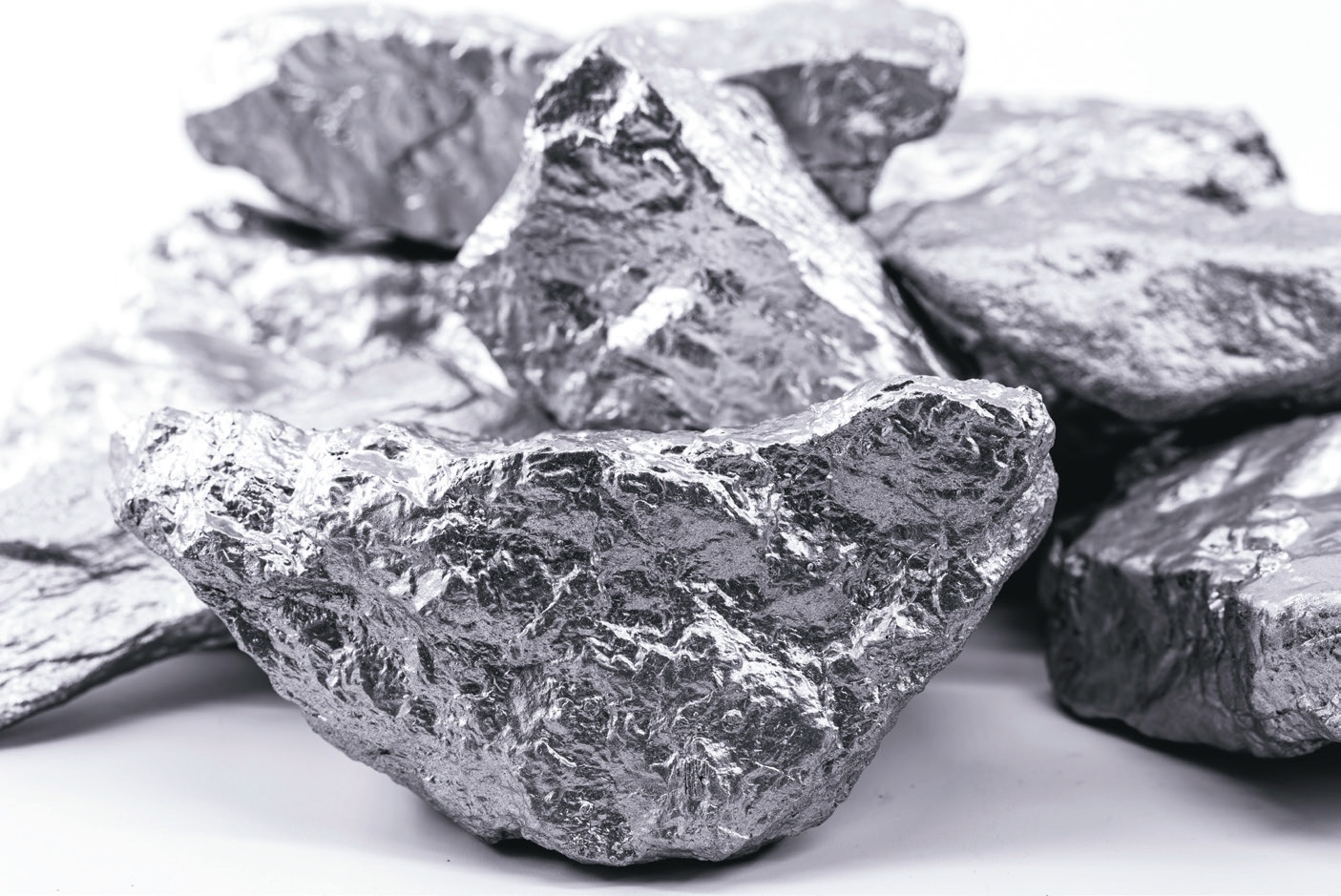 Approaches to “rational design”
Approaches to “rational design”
The reticence of customers and vendors is understandable, but they’re missing out. “There’s a real opportunity for an agile lubricants manufacturer to position itself in the growing space market by committing resources to systematic exploration of processing, structure and composition,” Lince says. Such an approach has already delivered results. Work at Sandia
6 has shown how important the surface microstructure is in defending against high initial friction (“run-in”) and oxidation, according to Curry, who adds, “It is our belief that tailoring the surface microstructure and composition of films can aid in reducing long-term oxidation and promote low initial friction.” Three avenues of development show promise.
Structural manipulation
When MoS
2 films are doped with other materials, they show better tribological and mechanical performance in non-vacuum conditions than pure MoS
2. Dopants currently used include Sb
2O
3, titanium, gold, carbon and others. The particles make the film more amorphous and, thus, more dense, so that water and oxygen are less able to penetrate or react with its microstructure. (The lack of crystallinity also improves mechanical properties.) Such films are already being used successfully on spacecraft.
According to Khare, a lot of work has been done in identifying suitable material combinations and optimal deposition parameters and the effect these have (and to what extent) on the tribology of MoS
2. However, he says, “Not enough is understood about the mechanisms through which these variables act. We need to be able to look in our material toolbox; pick X, Y and Z materials; add those as dopants; and have the film behave exactly the way we predicted. There are certainly some dopant candidates out there that might outperform ones that are currently used, but to identify them, we must develop a more complete understanding of why current dopants work as well as they do.”
In addition to adding dopants, Khare thinks there will be other pathways for adapting coating structures. “As the understanding of the microstructure improves, mechanisms might be exploited where you don’t need dopants. There’s already been work looking at the effect of grain orientation, for example. Or you might modify the grain size instead,” Khare says.
Adaptive coatings
Another strategy is to combine materials to produce adaptive “chameleon” coatings that can operate in different environments. To use a business analogy, structural manipulation is like skills training, which seeks to change an individual; an adaptive coating approach is like team building, where each team member has unique strengths that can be exploited. One example is a tungsten carbide/diamond-like carbon (DLC)/MoS
2 nanocomposite coating: The tungsten carbide provides a hard matrix; the DLC provides low friction and wear in humid environments; and the MoS
2 provides low friction and wear in dry and vacuum environments. Lince explains, “These coatings were designed for aerospace applications where both low and high humidities, as well as low and high temperatures, will be experienced by the same lubricated mechanism. For example, on a jet fighter, the DLC works well close to sea level, but when the jet gets to very high altitudes, where it’s much, much drier, the molybdenum disulfide kicks in.” Another in a gold matrix with encapsulated nanosized reservoirs of MoS
2 and DLC. This coating is designed for high-temperature applications, where MoS
2 doesn’t work as well. The YSZ provides a hard nanocrystalline matrix; the MoS
2 and DLC provide lubrication at room temperature in dry and moist environments; and the gold provides lubrication at temperatures above 500 C.
Computation
Because of the intrinsic challenges of ballon-plate studies—the ball hides important details from view—researchers are turning to computational modeling. Khare says, “I think in addition to advanced techniques in experimental tribology, computational studies of MoS
2 have a very significant role to play in enabling rational design of ultra-low-friction films. Their promise has already been shown with molecular dynamics studies on MoS
2, for example.
7,8 Even with the best experimental tools, one can only observe so much in real-time, so computational studies are essential for obtaining a more complete understanding of how mechanochemistry, for instance, influences observed phenomena at various length scales.”
Thinking outside the box
Curry thinks engineers will soon start to consider MoS
2 for a wider range of uses, including more terrestrial ones: “If the emerging material design approaches are successful, I’d expect requirements for MoS
2 applications to loosen, allowing for use in more non-hermetic applications. Engineers might be more willing to use these coatings even if some amounts of moisture are to be expected. I’d also like to think that advances made against aging in storage will allow for energy savings for specific components, as less initial friction can reduce startup motor torques and energies required to move. As in many cases with coating advancements, reducing friction can have widespread system impacts.”
Khare hopes that engineers and materials designers will start to think about MoS
2 at different length scales: “If someone’s been using MoS
2 at the larger scales, say for bearing applications, they might not recognize challenges and opportunities at the smaller length scales.” For Khare, the advances discussed in this article should prompt engineers to reconsider their ideas about performance limits within their applications and to be open to the idea that MoS
2 could be pushed beyond its current niche.
However, Lince has some reservations about one outside-the-box approach that is gaining currency: “Traditional solid lubricant coatings are increasingly being used on an ad-hoc, trial-and-error basis in combination with liquid lubricants (oils and greases). It might seem that using both approaches at once provides ‘double protection.’ But this assumption has not been adequately studied. One potential concern is that the liquid could actually impair solid lubricant performance by interfering with the formation of a transfer film. Scientific studies are clearly called for in this area.”
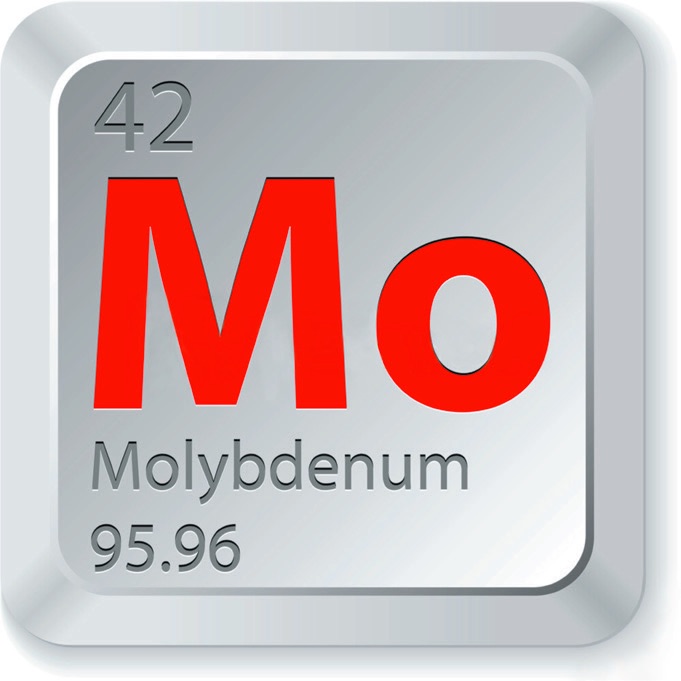
Still, the industry needs to encourage approaches that move beyond “heritage” materials, particularly in space and aerospace applications. A key element will be more partnerships, according to Lince: “Right now, the work of academics doesn’t make it to the coating manufacturers.” That isn’t sustainable because the space business is always moving forward. “It’s requirement creep: higher contact stress, higher contact pressure, higher loads. Or a system that needed to work for 50 million cycles now needs to work for 150 million cycles. And if you use the same old coating, it might or might not meet your new requirements,” Lince says. A manufacturer that has an established research capability or research partnership can be more responsive to customers. “They can say to a customer, ‘I see that you need greater endurance. We think that if we turn this knob, it will give us a better composition, and we can show you how this will give you the higher endurance that you need.’”
Conclusion
MoS
2 is rightly appreciated for demanding applications in vacuum, but research and emerging products show that it has the potential to break out of that niche. Sometimes the barrier is a past bad experience, Lince has found: “When a company has had a problem with oxidation in one of these lubricants, they generalize and don’t want to use it at all, even though there are different formulations that are less oxidation-sensitive. My challenge is finding ways to share these research details with customers, so they can become comfortable with more options, and at the same time be aware of their limitations.”
In the quest for materials that can withstand harsh environmental conditions (elevated temperatures, ionizing radiation, mechanical stress and wear, corrosive environments), while reliably providing low friction and wear, there are two paths forward that need more research and partnership. The first is expanded, rigorous work to characterize the actual coatings and performance, with a goal of understanding the connection between the tribological properties and the composition and nanostructure. The second, which depends to a degree, but not entirely, on the first, is exploring a broader space of material combinations to achieve coatings with flexible performance. The “diva” might never take up busking, but a more gracious attitude about requirements and a broader range of venues and repertoire are certainly in the realm of possibility.
REFERENCES
1.
Erdemir, A., Fenske, G.R., Eryilmaz, O.L. and Lee, R.H. (2003), “Method of produce ultra-low friction carbon films,” U.S. Patent No. 6548173B2.
2.
Curry’s cited work was funded by the Laboratory Directed Research and Development (LDRD) program at Sandia National Laboratories, a multi-mission laboratory managed and operated by National Technology and Engineering Solutions of Sandia, LLC, a wholly owned subsidiary of Honeywell International, Inc., for the U.S. Department of Energy’s National Nuclear Security Administration under contract DE-NA0003525. Any subjective views or opinions that might be expressed here do not necessarily represent the views of the U.S. Department of Energy or the United States Government.
3.
Lince, J.R., Loewenthal, S.H. and Clark, C.S. (2019), “Tribological and chemical effects of long-term humid air exposure on sputter-deposited nanocomposite MoS
2 coatings,”
Wear, pp. 432-433, article 202935. Available
here.
4.
Khare, H.S. and Burris, D.L. (2013), “The effects of environmental water and oxygen on the temperature-dependent friction of sputtered molybdenum disulfide,”
Tribology Letters, 52, pp. 485-493. Available
here.
5.
Khare, H.S. and Burris, D.L. (2014), “Surface and subsurface contributions of oxidation and moisture to room temperature friction of molybdenum disulfide,”
Tribology Letters, 53 (1), pp. 329-336. Available
here.
6.
Curry, J.F., et al. (2017), “Impact of microstructure on MoS
2 oxidation and friction,”
ACS Applied Materials & Interfaces, 9, pp. 28019-28026. Available
here.
7.
Vazirisereshk, M.R., Hasz, K., Carpick, R.W. and Martini, A. (2020), “Friction anisotropy of MoS
2: Effect of tip-sample contact quality,”
The Journal of Physical Chemistry Letters, 11 (16), pp. 6900-6906. Available
here.
8.
Vazirisereshk, M.R., Ye, H., Ye, Z., et al. (2019), “Origin of nanoscale friction contrast between supported graphene, MoS
2, and a graphene/MoS
2 heterostructure,”
Nano Letters, 19, (8), pp. 5496-5505. Available
here.
FOR FURTHER READING
1.
Scharf, T.W. and Prasad, S.V. (2013), “Solid lubricants: A review,”
Journal of Materials Science, 48 (2), pp. 511-531. Available
here.
2.
Dugger, M.T. (2017), “Solid lubricants,” in
ASM Handbook on Friction, Lubrication, and Wear Technology, 18, Totten, G.E., ed., Materials Park, Ohio: ASM International, pp. 191-206. Available
here.
3.
Scharf, T.R. (2017), “Transition metal dichalcogenide-based (MoS
2, WS
2) coatings,” in Totten, G. E., ed.,
ASM Handbook on Friction, Lubrication, and Wear Technology, 18, pp. 583-596, Materials Park, Ohio: ASM International. Available
here.
4.
Vazirisereshk, M.R., Martini, A., Strubbe, D.A. and Baykara, M.Z. (2019), “Solid lubrication with MoS
2: A review,”
Lubricants, 7 (7), pp. 57-91. Available
here.
5.
Vakis, A.I., Yastrebov, V.A., Scheibert, J., et al. (2018), “Modeling and simulation in tribology across scales: An overview,”
Tribology International, 125, pp. 169-199. Available
here.
6.
Lince, J.R. (2020), “Effective application of solid lubricants in spacecraft mechanisms,”
Lubricants, 8 (7), pp. 74-130, especially section 8.4 on adaptive coatings. Available
here.
Jane Marie Andrew is a freelance science writer and editor based in the Chicago area. You can contact her at jane@janemarieandrew.com.